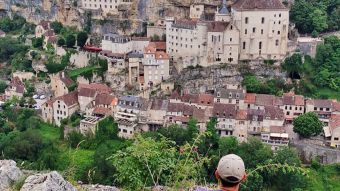
Rocamadour, Padirac & more The marvellous Dordogne Valley
Heritage, nature sites and fine cuisine
A truly magnificent region
For your holidays, do you look for a preserved environment with amazing nature sites? Maybe a destination steeped in history? Or an area rich in flavour? If you answered “yes” to any of these, you’re in for a treat, because our region boasts a combination of all these delights! Fans of grandiose nature will need to visit us more than once to make the rounds of all our treasures: the unforgettable, must-see Gouffre de Padirac caves of course, but also other caves with prestigious histories (Lacave, Merveilles, Presque and more) and breathtaking scenery (at Causses du Quercy Nature Park, etc.) which you can explore on foot, by bicycle or from a canoe or kayak. History buffs will likewise be enamoured with those caves of course, but also with internationally renowned villages typical of the region (some of them designated as Most Beautiful Villages in France), like Rocamadour, Autoire, Sarlat, Martel and others. And attention all foodies: you will not feel indifferent about our specialities like duck (breast, confit and gizzard), foie gras, walnuts, goat cheese, and more. We look forward to seeing you soon!
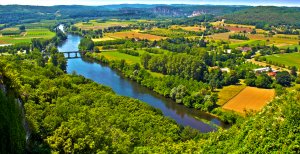
The Causses du Quercy have an exceptional geological heritage and an identity represented by the link between Man and Stone. Already labeled Regional Natural Park for the richness and diversity of its natural environment, it becomes in 2017 UNESCO Global Geopark.
The Geopark Label is awarded to territories with a remarkable geological heritage.
Around the world, UNESCO Geoparks are striving to protect and enhance geodiversity. They tell the story of the 4.6 billion years of Earth's history, as well as the geological events that shaped it while shaping the evolution of humanity itself. They reflect past climate change, while providing data on current challenges.
There are now 127 Geoparks around the world, including 70 in Europe and 6 in France. The Regional Natural Park of Causses du Quercy joined them in May 2017.
The Causses du Quercy Regional Natural Park includes a very wide variety of natural habitats: cliffs, sinkholes, chasms, dry grasslands, oak forests ... An arid plateau lined with dry stone walls and populated with sheeps, it is closely linked to the 'human activity.
Today we take pleasure in discovering the park's rich heritage and natural heritage on the numerous hiking and biking trails. Small villages, resurgences with turquoise waters, caves and streams ... Each path reveals a surprising discovery.
The emblematic places within the Parc des Causses du Quercy
In the north of the Park, clinging to the cliff, the sacred city of Rocamadour stands and reveals 1000 years of history. A few kilometers away, and equally vertiginous, the Gouffre de Padirac, a huge chasm, embarks travelers on an underground river 103 meters deep.
Further south, the village of Saint-Cirq Lapopie dominates the waters of the Lot. Not to mention the beautifully preserved prehistoric caves "des Merveilles" of the Wonders) or of Pech-Merle where you can still admire the original paintings left by our distant ancestors.
The karst plateau has favored the creation of this exceptional geological heritage. Drop by drop, the infiltration of water in the calcareous soil created caves and chasms, underground rivers and galleries, concretions and underground lakes for the greatest pleasure of speleologists and other explorers.
The lithic landscape of the Causse
The stone is omnipresent here. In the Causses du Quercy, a close bond has been woven between limestone and man since prehistoric times: menhirs, dolmens, dry stone walls, cazelles and gariottes ... This symbiosis has shaped the landscape and the rural architecture, conferring to this territory a unique decor.
The landscapes of the Causses du Quercy appear as a harmonious natural whole of which Man managed to preserve the patrimonial rich heritage. Multiple caves, chasms and resurgences form an essential underground network for all lovers of caving and cave diving.
The purest starry sky of France
The specificity of this Regional Natural Park does not stop there because it is endowed with another exceptional asset: we can observe there the purest starry sky of France thanks to its very weak light pollution. It's called the Black Triangle. Stars, planets, Milky Way, you will not find a better place to observe them!
Family discoveries
In the Regional Natural Park of Causses du Quercy, each activity, each place, each visit is a pretext for a new adventure to live with family. The park invites you to explore caves, rivers, villages or just a small path on the Causse.
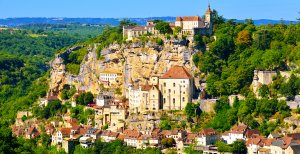
This extraordinary village will give you a vertiginous impression of unique spectacle over a tiny canyon where the Alzou flows. Religious city, known from the 12th century by the pilgrims, it is still the venerated sanctuary of the Black Virgin and arouses as much admiration. Its monumental staircase will allow you to appreciate this medieval village.
Rocamadour is above all a place of pilgrimage. From the 12th century, it attracts sovereigns and saints from all over Europe. The growing success, the small city is gradually covered with religious buildings and fortification. In the 15th century, pilgrimages going out of fashion, Rocamadour slowly fell asleep. It was not until 1858 that important restoration works began. The troubadour neo-gothic style is then in vogue and prints the village with its seal.
The village is composed of 3 parts:
The village
The sanctuary
The castle
The oldest buildings date from the Middle Ages but the occupation of its cliffs dates back to the origins of man. A small oratory to the virgin was created under the rock in medieval times. The relics of Saint Amadour were discovered in the 12th century, which gave its name to the city. It was at this time that many miracles were attributed to the Virgin of Rocamadour and several chapels and shrines were built.
Rocamadour became one of the most important places of pilgrimage in all of Christendom.
The sanctuary has 7 chapels:
The Basilica of Saint Savior
The Palace of Bishops
The Notre-Dame de Rocamadour Chapel where the Black Virgin is
The Saint-Michel Chapel
The Saint-Louis Chapel
Saint-Anne, Saint-Blaise and Saint-Jean-Baptiste Chapels
The Crypt of Saint Amadour
What to do in Rocamadour?
Le Rocher des Aigles (Rock of the Eagles)
A site opened in 1977 and today has more than 400 birds of 60 different species.
Vultures, Condors, Eagles, Falcons but also Aras, Cockatoos and other parrots evolve in complete freedom. During the show, we let our eyes go to the rhythm of the evolutions of the birds and we discover their way of life, of hunting, the habitat in which they evolve as well as the diet which suits them the best.
For more information: www.rocherdesaigles.com
Parc Durandal (Durandal Park)
Equestrian stunts, fights, picturesque characters, offbeat humor, great complicity and closeness to artists: welcome to Parc Durandal!
This show is for everyone and is played in a nice and shady park.
For more information: www.rlproductions.fr
La Forêt des Singes (The Monkey Forest)
Popcorn hidden in the hand: you are ready to immerse yourself for 1h30, in the fascinating universe of more than 150 macaques of Barbary.
In Rocamadour, in this forest of 20 hectares, they evolve in freedom, but near you, until pilfering in your hand the popcorn which is offered to you at the entrance.
Guides are located throughout the course. Do not miss the feeding sessions that are offered at regular intervals. In addition to feeding the monkeys, you will discover lots of exciting information about this species that is unfortunately threatened and classified as "endangered".
For more information: www.la-foret-des-singes.com
Les Montgolfiades (a hot air balloon show)
Every year, at the end of September, the Montgolfiades take place in Rocamadour.
Two days of festivities in the Dordogne Valley which are punctuated by the flight of thirty balloons from the canyon of Alzou, dominated by the medieval city of Rocamadour ...
For more information: www.rocamadouraerostat.fr
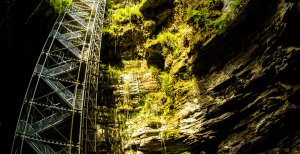
Located on the edge of the Causses du Quercy Regional Natural Park, Padirac is a village marked by the past as evidenced by its castle, the Saint-Julien church and the Romanesque chapel of the 11th century, the Roman road and the many dolmens nearby.
Padirac is nowadays one of the world's leading tourist centers thanks to its chasm, explored in 1889 by the speleologist Edouard-Alfred Martel, but known for much longer by its inhabitants who sometimes found refuge there. This was particularly the case during the Hundred Years War and during the Wars of Religion.
Today the chasm of Padirac is considered one of the greatest geological curiosities of France. It has a monumental entrance of 35m diameter at the bottom of which, at 103m deep, flows an underground river. Each year thousands of visitors come to admire, in boat and then on foot, majestic galleries and monumental concretions.
What to do in Padirac?
Le Gouffre de Padirac (The Chasm of Padirac)
World famous, the Gouffre de Padirac is the first chasm in France and one of the most fascinating to explore in Europe. The hole is 35 meters in diameter and at the bottom, 103 meters underground, runs the Padirac River which flows in a network of 40kms galleries, knowing that only 2kms of galleries are open to the public. The visit is by boat on the underground river and then on foot. The route goes through immense halls and breathtaking beauty through the successive discovery of the Great Pendeloque, stalagmite more than 60 meters high suspended over the Rain Lake, the Gours Lake, natural dam succession and the Great Hall Dome, 94 meters under ceiling. The visit of the Chasm of Padirac is essential during your stay in the Lot.
In high season, the chasm of Padirac is a victim of its success! An online booking on the Gouffre de Padirac site is strongly recommended to avoid an endless queue.
For more information: www.gouffre-de-padirac.com
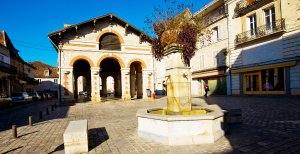
Gramat is a picturesque and commercial village steeped in history located in the heart of the Regional Natural Park of Causses du Quercy.
Today, Gramat's activity is focused on crafts and commerce. Because of this, it is pleasant to stroll on the market on Tuesdays and Fridays morning under the superb market hall located on the village square.
What to do in Gramat?
Parc Animalier de Gramat (Gramat's Wildlife Park)
The Parc Animalier de Gramat (Gramat's Wildlife Park) offers a walk of approximately 2 hours on 40 shaded hectares of the Causse to discover more than 150 species of wild and domestic animals: Wolves, Bears, Lynx, Otters, Bisons, many cervids ...
For more information: www.gramat-parc-animalier.com
National Cynophilist Training Center
Every Thursday afternoon, from June to September, the National Cynophilist Training Center of the Gendarmerie of Gramat organizes free demonstration of training dog handlers of the gendarmerie and the visit of the school.
For more information: chiengendarmerie.pagesperso-orange.fr
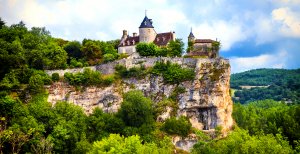
Ideally located on the banks of the Dordogne, Lacave is a small village with many heritage, historical, gastronomic and tourist attractions.
All the riches of the Dordogne Valley are here together: an exceptional underground world, magnificent pebble beaches, a prehistoric park, two castles, two starred restaurants, a magnificent church listed as a Historic Monument, not to mention a whole range of activities with splendid hikes, caving, swimming, canoeing and even the best places to practice fly fishing!
What to do in Lacave?
Les Grottes de Lacave (the Caves of Lacave)
Discovered in 1902 by Armand Viré, the Lacave caves have been open to the public for over a hundred years. The access is done in small electric train before discovering on foot majestic rooms like the room of the Mirages or that of the Merveilles (Wonders), a room of 2000m2 where the black light seems to animate some amazing concretions there.
For more info: http://www.lacave.fr/en/tourism/touristic-activities.html
La Grotte des Carbonières (the Cave of Carbonnières)
This cave discovered in the early 2000s has the distinction of being very accessible (including wheelchair). Indeed, the accesses were arranged for this purpose: no staircase comes to mark the route of the visit.
The visit lasts approximately 1 hour. In the company of a guide, you will be introduced to the magical power of water, able to carve an incredible number of mineral concretions all more surprising than the others: stalactites, stalagmites and fistulas with crystal clear whiteness. You will also learn that the man has already come into this cavity (a long time ago!).
For more info: http://grottedescarbonnieres.com/
The castles of Lacave
Castle of La Treyne
Built on a cliff overlooking the left bank of the Dordogne, the castle of La Treyne is accompanied by a vast park with century-old trees. We can also visit the gardens.
All buildings date from the 17th century, with the exception of the 14th century square tower.
The terrace offers a superb view of the meanders of the river.
The Château de la Treyne (Relais et Châteaux ****) is now a magnificent hotel-restaurant.
Castle of Belcastel
The village of Lacave, nestled against a hill at the entrance of the caves, is dominated on the other side by the castle of Belcastel.
Built around 930 by Adhémar des Echelles, viscount of Turenne, and several times rebuilt, it rises on a rocky outcrop dominating the confluence of the Ouysse and the Dordogne.
This private castle retains of its medieval foundation only part of the main building, the donjon and the chapel.
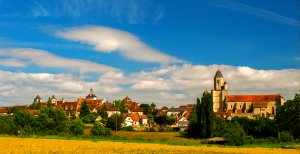
Martel, built on the causse that bears his name, is one of the few cities that does not owe its existence to a castrum or religious foundation. It was born from a convergence of roads, an ancient North-South axis crossing a West-East axis where the precious salt of the Atlantic and the wine of Aquitaine passed.
This privileged location makes Martel a rich market town from the beginning of the 12th century. At the same time, it becomes an important stage on the pilgrimage route to Rocamadour. Its coat of arms decorated with three hammers indicates that it was also populated by many craftsmen.
Martel had a second period of glory in the 19th century thanks to the truffle trade.
Today Martel remains a dynamic city, where shops and events complete a remarkable heritage. You will enjoy strolling on the market on Wednesdays and Saturday mornings under the beautiful hall located in the heart of the village.
What to do in Martel?
Reptiland
Discover the most beautiful collection of reptiles in Europe exposed in daylight, but also the largest in France venomous species ... Snakes, turtles, lizards, crocodiles, tarantulas and Scorpions, in a covered and air-conditioned space. Come change your vision of reptiles!
For more information: www.reptiland-le-renouveau.fr
Le Moulin à l'Huile de Noix (The Walnut Oil Mill)
As early as 1830 the walnut oil mill is listed on the first cadastre as an oil presser.
The mill has two wheels, one of which is still in use. The stone mill grinds the kernels, a skillet moderately heats the dough, which then returns to the press from which the oil is extracted.
The mill does a custom work where customers bring their kernels.
The site visit is free and the sale of walnut oil is made on site.
The Truffadou
Discovery of the Dordogne Valley by the old railway line cut into the cliff 80 meters high. Each trip is scheduled from Martel to Saint Denis (Round trip). Depending on the schedule, a magnificent steam locomotive or a powerful diesel is at the head of the train near Martel station, ready to take you on a fantastic journey. A 13 km return trip on a corniche to discover the Dordogne Valley and its admirable panoramas.
For more information: www.trainduhautquercy.info
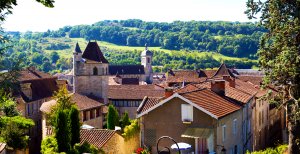
Between the valleys of Lot and Célé, Figeac will lead you in the footsteps of Champollion, the decipherer of hieroglyphs.
Figeac will seduce you with its vitality and charm, but also with its surrounding landscapes: mountainous reliefs announcing in the north the Massif Central, pastoral landscapes of the Causses du Quercy, meanders and cliffs of the Célé Valley.
The situation of Figeac has made it a flourishing city. From the 12th century, it was imposed by its commercial vocation and became a stage on the way to Santiago de Compostela. Today, Figeac wakes up on Saturday morning with a colorful market that makes the city vibrate!
What to do in Figeac?
The Champollion Museum
The Champollion Museum - The Scriptures of the World - is installed in the family home of the Egyptologist. It brings together collections of writing objects and writings from around the world that express the wonderful diversity of cultures. An exciting journey of which Champollion is both the hero and the guide.
For more information: www.musee-champollion.fr
The little train
You will take a guided walk in the old town of Figeac, on the banks of the Célé and in the historic districts.
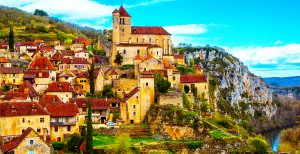
Perched above the River Lot, the medieval village adjusts to its cliff in a spectacular way.
Straight out of the Middle Ages, this village partly classified as a historical monument, can be discovered on foot, as if to be better impregnated by the nobility of its architecture, the elegance of these arcades, its stairs, its fortified doors.
Once a witness to a thriving river life, famous for its woodturners, Saint-Cirq-Lapopie is a classified site comprising 13 historical monuments. The village has retained all of its heritage, but above all a crazy charm. Stalls, restaurants and cafes shelter from the sun in the shadow of ogival doors, while the site surprises by its overall harmony, which earned him to be voted the favorite village of the French in 2012!
For more information: www.saint-cirqlapopie.com
What to do in Saint-Cirq-Lapopie?
The Rignault Museum
The Rignault Museum is first and foremost a typical Saint-Cirq house which gives the opportunity to enter the intimacy of the village and which houses the private collection of its owner. Above all do not miss the beautiful gardens that offer breathtaking views of the Lot Valley. From April to October, this precious mineral, vegetable, historical and artistic jewel, transports you beyond time and space, between sky and river, between stone and flowers, between history and present.
The cruises of Saint-Cirq-Lapopie
It is in Bouziès in the heart of the Lot Valley or at the St Cirq Lapopie nautical stop that you will embark on your cruise aboard authentic wooden barges. The towpath cut in the cliff, manual lock that the sailor will activate before your eyes and of course the breathtaking view of the perched village of St-Cirq Lapopie are the highlights of this ride over the water.
For more information: www.croisieres-saint-cirq-lapopie.com
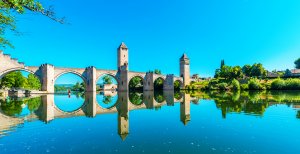
You like the charm and the discovery of the medieval cities, you like to venture into the alleys to discover the riches of our past, then come to discover the superb heritage of the city of Cahors, from the Gallo-Roman time to the present day, where there are no less than 18 buildings classified as Historical Monuments.
The jewels of the city of Cahorsthat are the Pont Valentré and the St-Etienne Cathedral, both classified as World Heritage by UNESCO, as part of the paths of Santiago de Compostela, will allow you to dive back into the extraordinary adventure of the builders.
What to do in Cahors?
Le Pont Valentré (The Valentré Bridge)
The Valentré Bridge, emblem of the city that crosses the river carrying its three fortified towers. You can stroll on foot or approach by boat during a ride on the Lot. 14th century building, the Valentré bridge is a World Heritage Site by UNESCO, under the paths of Santiago de Compostela. A legend involving the devil is associated with this bridge so look up to see it!
The Cathedral of Cahors
The Cathedral of Cahors whose first foundations date back to the 7th century, was rebuilt in the early 12th century and completed in the 13th century. The peculiarity of this building is its nave covered with two cupolas among the largest in the Southwest. You can also stroll through the flamboyant Gothic cloister dating back to the 16th century.
The market on the doorstep of the Cathedral
An appointment not to be missed, all year long, on Wednesday and Saturday morning: the Cahors market which is held at the doors of the Saint-Etienne cathedral. Here, everything puts in appetite: Rocamadour cheeses, Perigord walnuts, foie gras, Quercy melon, Cahors wines.
Cahors is indeed at the doors of the vineyard that bears his name since the time of Francis I. This historic Malbec terroir, the main grape of the appellation, offers many areas to visit with a tasting at the key!
For lovers of hiking, you can stretch your legs by walking the path of Santiago de Compostela towards Moissac and also take various paths or cross the Lot and join the Mont Saint-Cyr, hill overlooking the city, from where you can take pictures of the whole city and admire the riches of the surrounding nature.
The city of Cahors also proposes to combine botany, hiking and discovery through secret gardens, located throughout the territory of Cahors, classified Remarkable Gardens, unique in the south of France and highlight the heritage and history of the city, culminating in the CAHORS JUIN JARDINS (CAHORS JUNE GARDENS) event.
In July, for lovers of blues, CAHORS BLUES FESTIVAL Association organizes its international festival and offer you many concerts.